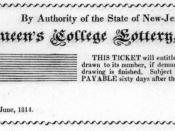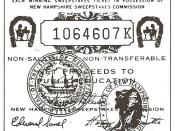I. Introduction
Lotteries held a prominent place in the early history of the United States, including a role in the financing the establishment of the first British colonies. They where frequently used to finance public works projects such as paving streets, building wharves and constructing churches. Most of the early lotteries in the United States were run by state and local governments, but during the 19th century, a number of private companies were hired by governments to operate and market public lotteries. After a number of celebrated cases of fraud in these privatized lotteries, most states moved to ban lotteries. By 1894, no state permitted lotteries and 35 states had constitutional prohibitions against them (Clotfelter and Cook, 1989).
Over the past forty years there has been a rapid growth in both the number and size of state lotteries in the United States. In 1964, New Hampshire became the first state since 1894 to run a lottery.
Since then, 37 other states and the District of Columbia have instituted lotteries. Today, most states offer five main types of lotteries: instant games, daily numbers, lotto, electronic terminal for keno and video lottery. The gross sale of lottery tickets now exceeds $37 billion a year, adding about $12 billion a year to state budgets (Evans and Zhang, 2002, pg 3).
Figure 1, is a graph of total lottery ticket sales and profits during fiscal years (October 1 to September 31) 1970 to 2000 in real 1996 dollars. As the numbers in Figure 1 illustrate,the growth in the size of state lotteries has been staggering. In fiscal year 1970, when only New Hampshire and New York ran state lotteries, total ticket sales amounted to$201 million. By FY2000, the total lottery ticket salesreached $34.0 billion, about 0.4 percent of the GDP and added $10.8...


